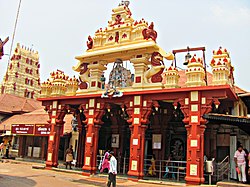A request that this article title be changed to Sat Vaishnavism is under discussion. Please do not move this article until the discussion is closed. |
 The Entrance to Sri Krishna Matha at Udupi | |
| Regions with significant populations | |
|---|---|
| Karnataka, Maharashtra, Tamil nadu, Andhra Pradesh | |
| Religions | |
| Vaishnavism (Hinduism) | |
| Scriptures | |
| Vedas, Upanishads, Bhagavat Gita, Brahma Sutra, Pancharatra, Bhagavata Purana, Mahabharata, Ramayana, Sarvamula Granthas | |
| Languages | |
| Sanskrit, Kannada |
| Part of a series on |
| Vaishnavism |
|---|
 |
Sad Vaishnavism[note 1] (Sanskrit: सद्वैष्णवसम्प्रदाय), (popularly referred as Madhva Sampradaya, Madhva Vaishnavism and Brahma Sampradaya), is a denomination within the Vaishnavism—Bhagavata tradition of Hinduism.[2][3] Sad Vaishnavism was founded by thirteenth century philosopher-saint Madhvacharya, who developed the Tattvavada (dvaita) ("arguments from a realist viewpoint") Vedanta sub-school of Hindu philosophy.[4]
The tradition traces its roots to the ancient Vedas and Pancharatra texts. The Madhva Sampradaya or Sad Vaishnava Sampradaya is referred to as the Brahma Sampradaya, referring to its traditional origins in the succession of spiritual masters (gurus) have originated from Brahma.[5]
Madhva championed the ultimate reality as personal and Saguna Brahman ("the absolute with qualities") and it is Lord Vishnu (Narayana). Hence god Vishnu (Narayana) along with his consort Lakshmi, and their divine incarnations and forms are revered and worshipped in this tradition. In Sad Vaishnavism, the creator is superior to the creation, and hence moksha comes only from the grace of Vishnu, but not from effort alone.[6] In Sad Vaishnavism Jnana, Bhakti and Vairagya are necessary steps for moksha and doing Karma is also considered a form of puja. Hence in Sad Vaishnavism, Jnana Yoga, Bhakti Yoga and Karma Yoga are equally important in order to attain liberation (moksha) compared to Sri Vaishnavism where bhakti yoga alone is enough to attain moksha. However Madhva holds the perspective that not all jivas are destined for liberation and rejects the idea of an inherent principle linking a jiva's existence with liberation. However, he acknowledges the presence of divine grace at work within chosen individuals.[7]
- ^ Ian Philip McGreal (1995). Great Thinkers of the Eastern World: The Major Thinkers and the Philosophical and Religious Classics of China, India, Japan, Korea, and the World of Islam. HarperCollins Publishers. p. 232. ISBN 9780062700858.
- ^ Guy L. Beck (2012). Alternative Krishnas: Regional and Vernacular Variations on a Hindu Deity. SUNY Press. p. 74. ISBN 9780791483411.
- ^ Suresh K. Sharma, Usha Sharma (1999). Rajasthan Through the Ages: Art, architecture and memoirs. Deep & Deep Publications. p. 333. ISBN 9788176291552.
- ^ Nagendra Kr Singh; A. P. Mishra (2005). Encyclopaedia of Oriental Philosophy and Religion: A Continuing Series--, Volume 1. Global Vision Pub House. p. 99. ISBN 9788182200722.
- ^ Harold Coward (30 October 1987). Modern Indian Responses to Religious Pluralism. SUNY Press. p. 129. ISBN 9780887065729.
- ^ Lavanya Vemsani (13 June 2016). Krishna in History, Thought, and Culture: An Encyclopedia of the Hindu Lord of Many Names: An Encyclopedia of the Hindu Lord of Many Names. ABC-CLIO. p. 165. ISBN 9781610692113. Retrieved 13 June 2016.
- ^ Mittal, Sushil (2004). THE HINDU WORLD. 29 West 35th Street, New York, NY 10001: Routledge. p. 292. ISBN 0-203-64470-0.
{{cite book}}: CS1 maint: location (link)
Cite error: There are <ref group=note> tags on this page, but the references will not show without a {{reflist|group=note}} template (see the help page).
